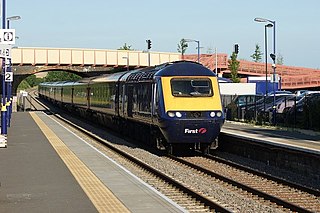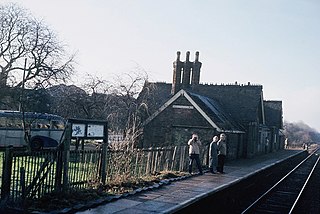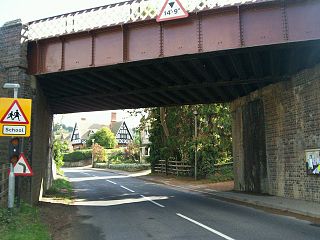
The Gloucestershire Warwickshire Steam Railway is a volunteer-run heritage railway which runs along the Gloucestershire/Worcestershire border of the Cotswolds, England.

Winchcombe railway station is a heritage railway station which serves the town of Winchcombe in Gloucestershire, England. The stations itself is actually located in the nearby village of Greet. It is located on the Honeybourne Line which linked Cheltenham and Stratford-upon-Avon and which was opened by the Great Western Railway in 1906. The station closed to passengers in 1960, although the line itself remained open for freight and diversionary use until 1976, when a freight train derailed near Winchcombe and damaged the track.

Stratford-upon-Avon railway station is the southern terminus of the North Warwickshire Line and Leamington-Stratford line, serving the town of Stratford-upon-Avon in Warwickshire, England. The station is served by West Midlands Trains (WMT) and Chiltern Railways.

Honeybourne railway station serves the village of Honeybourne in Worcestershire, England. Opened in 1853, it is on the Cotswold Line and was formerly a busy junction with five platform faces, also serving trains on the Great Western Railway's Honeybourne Line between Cheltenham Spa and Stratford-upon-Avon, which formed part of a strategic route between the West Midlands and the West of England.

Winslow railway station refers to either one of two railway stations which historically served or is planned to serve, the town of Winslow in north Buckinghamshire, England. The original station (1850–1968) was on the former Varsity Line between Cambridge and Oxford. As of September 2022, construction of a new station nears completion and is scheduled to be served by East West Rail, as part of the plan to reinstate the Oxford–Cambridge service.

Olney was a railway station on the former Bedford to Northampton Line and Stratford-upon-Avon and Midland Junction Railway which served the town of Olney in Buckinghamshire, England. It was situated on a busy section of line between Towcester and Ravenstone Wood junction which saw heavy use by freight services running between Wales and north-east England. The station closed for passengers in 1962 and completely in 1964, the various connecting routes to the line having closed one by one from the 1950s onwards.
Witney goods station served the Oxfordshire town of Witney on the Oxford, Witney and Fairford Railway. It consisted of seven sidings, a goods shed, a wooden parcel office and a cattle dock. It also had an engine shed, which was demolished early in the twentieth century. Following the opening of the East Gloucestershire Railway in 1873, the station became a goods depot, with passengers using the second station situated to the south. The original station remained open to goods traffic until 1970.

Fairford railway station served the town of Fairford in Gloucestershire. It was the western terminus of the Oxford, Witney and Fairford Railway between Oxford and Fairford. It had one platform, and a stone-built station building.

Broom Junction was a railway station serving the village of Broom in Warwickshire, England. It was an interchange for both the Stratford-upon-Avon and Midland Junction Railway and the Barnt Green to Ashchurch line.
Stratford-upon-Avon Racecourse Platform was a railway station on the Stratford upon Avon to Cheltenham section of the Honeybourne Line. Located one mile south of the town centre, its purpose was to serve Stratford Racecourse. It closed in 1968 as a result of falling passenger numbers.

Milcote railway station was a station on the Great Western Railway line between Stratford-upon-Avon and Honeybourne, which in 1908 became part of the Great Western Railway's new main line between Birmingham and Cheltenham.

Chambers Crossing Halt railway station was a timber-framed railway halt on the Stratford-upon-Avon to Cheltenham section of the Honeybourne Line. The station was located two miles south-west of Stratford upon Avon. The site of the station is now part of the Stratford greenway and may in future form part of the Gloucestershire Warwickshire Railway's northern extension from Toddington.

Cheltenham Spa Malvern Road railway station was a station in the town of Cheltenham.

Cheltenham Spa St. James railway station was a station in the town of Cheltenham.
Laverton Halt railway station was a halt on the Honeybourne Line from Honeybourne to Cheltenham which served the hamlet of Laverton in Gloucestershire between 1905 and 1960.

Hayles Abbey Halt railway station is a halt opened by the Great Western Railway on the Honeybourne Line from Honeybourne to Cheltenham which served the hamlet of Hailes in Gloucestershire, as well as the nearby Hailes Abbey, between 1928 and 1960. The line through the site of the station was reinstated in 1985 and opened in 1987 by the Gloucestershire Warwickshire Railway, although for many years no new halt was provided. The halt was eventually reopened on 5 June 2017 after being rebuilt by volunteers. Unlike the original, however, it only has a single platform. It lies between Toddington and Winchcombe stations.

Gretton Halt railway station was a halt opened by the Great Western Railway on the Honeybourne Line from Honeybourne to Cheltenham which served the small village of Gretton in Gloucestershire between 1906 and 1960. The line through the site of the station was reinstated in 1997 by the Gloucestershire Warwickshire Railway, although no new halt was provided.

Weston-sub-Edge railway station is a disused station on the Honeybourne Line from Stratford-upon-Avon to Cheltenham which served the village of Weston-sub-Edge in Gloucestershire between 1904 and 1960.

Willersey Halt railway station served the village of Willersey, Gloucestershire, England between 1904 and 1960.
The Stratford on Avon Railway was a branch railway line opened in 1860, to connect the town of Stratford-upon-Avon to the Great Western Railway main line at Hatton, in England. It was worked by the GWR. In 1861 it was connected through Stratford to a branch line from Honeybourne, and this later enabled the development of a through mineral traffic. The company was absorbed by the GWR in 1883.





















